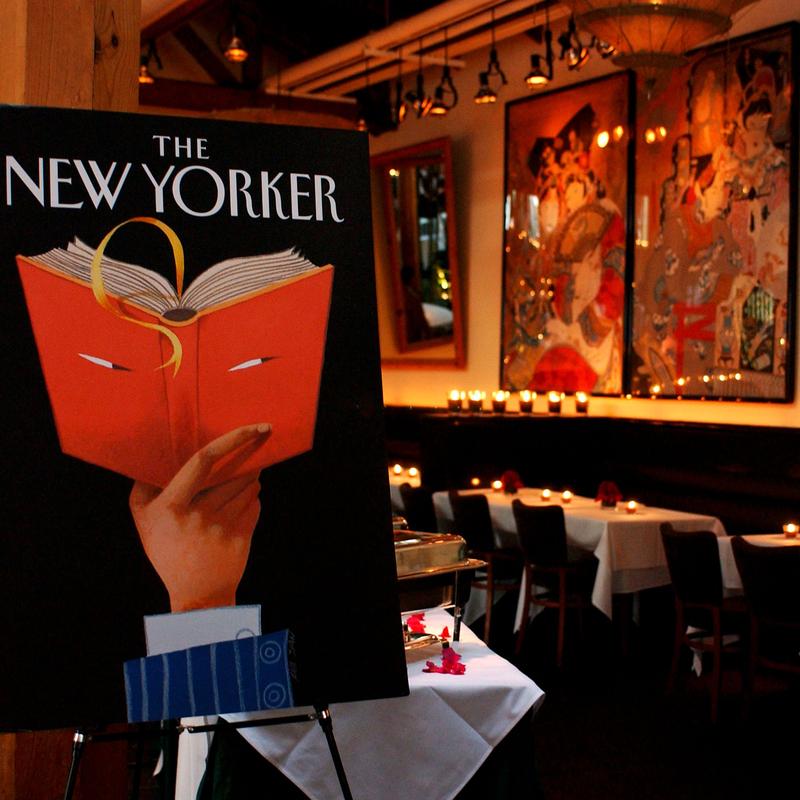The New Yorker Celebrates a Hundred Years as a Poetry and Fiction Tastemaker

David Remnick: In February, a couple of weeks from now, The New Yorker will mark its centenary. 100 years of publishing, and yet, when we began, The New Yorker's founding editor, Harold Ross, saw the magazine almost purely as what he called a comic paper. Those first issues were light as air. Once Ross made the crucial hire of Katherine White, an editor who insisted on bringing the best of fiction and poetry to the magazine, things changed. Over a century's worth of issues, we've published an immense body of short fiction and poems.
Deborah Treisman: The New Yorker has published, in its history, close to 14,000 pieces of fiction.
David Remnick: You went back and read every single one? How many poems? Do you have any idea, Kevin?
Kevin Young: I think you might eclipse us. I think we're 13,500 or something like that.
David Remnick: Deborah Treisman and Kevin Young have put together two anthologies to celebrate The New Yorker centennial. Deborah has been the magazine's fiction editor and my colleague since 2003, and she's edited A Century of Fiction at The New Yorker. Kevin joined us as poetry editor in 2017. He's an amazing poet and the director of the Smithsonian's National Museum of African American History and Culture. In his spare time, he's edited the new book A Century of Poetry at The New Yorker. Kevin, you said that when you were growing up, you bought a copy of The New Yorker Book of Poems Anthology, which was published in 1969. What do you remember about reading that book about who was included and maybe, at least as much to the point, who was not?
Kevin Young: I remember vividly reading it, and I still have my copy, and it's very neatly underlined in ink, which I wouldn't do now. I'm a pencil guy mostly. To see James Dicke's Falling, for instance, which is this bravura piece. It's pages and pages. I'm not sure we would even run something as long as that, but to see it--
Deborah Treisman: I would hope that we would. Keep that in mind.
Kevin Young: Okay. You've heard it, folks. You've heard it, folks. It was surprising when you asked me to do this. I think my first response was, "I've only wanted to do this since I was 15." I've been thinking about this idea, and so it was a dream come true. I pulled the book off the shelf and saw my underlines, and we was so excited. Then I realized there's not one person of color in that whole book.
David Remnick: Then you, who come along so many years later, were only the sixth Black poet in our pages.
Kevin Young: 1999. That's a long time.
David Remnick: What accounts for that?
Kevin Young: It was missing a lot of opportunities for the range of American poetry. It wasn't just African American poets. It's missing Asian poetry. It's missing the long tradition of Asian poetry or African poetry. It doesn't include that in translation, even. An anthology, we have the advantage of looking back and selecting and saying, "Well, that's obvious," as Deborah is saying. It isn't always in the process. What is interesting to me is I haven't gone through the archive and figured out, is it people didn't send? There is a level of, if it's not welcoming, why would you send your poem there at the start?
David Remnick: The big poets in the '50s, I think they would have found The New Yorker anthemia somehow.
Kevin Young: Exactly. The New York school often, until-- Then, Ashbury's in, and then he was in a lot. That's what's interesting is it isn't one taste only. You have someone like Sister Sonia Sanchez, a wonderful poet. She was taught by Louise Bogan and that connection to The New Yorker was there for her in the beginning. In a way, there is this tie, even though it's not shown in the magazine. I think there's a lot of interesting connection still.
David Remnick: I was over at the New York Public Library yesterday, and one of the archivists showed me some correspondence between the fiction department and Jerry Salinger, J.D. Salinger. The first note is a very curt, "No, thank you." It suddenly gets a lot warmer. As a fiction editor, even today, do you live in fear of missing a potential genius? When things come in, what are you always thinking?
Deborah Treisman: The thing to remember is that even geniuses don't always write their best work right off the bat. People make a lot of noise about rejection letters from The New Yorker that went to famous writers or later famous writers, and they were probably justified, those rejections.
David Remnick: [unintelligible 00:04:40] 44 rejections before Roger Angel took--
Deborah Treisman: I think it was only 13, but--
David Remnick: 44, 13.
Deborah Treisman: He wrote her very detailed letters about what he was exasperated with in her work and encouraging her to do something different. At least he spotted that she had something fresh and interesting and different, and he encouraged that.
David Remnick: There was a period, a long period, where people would refer to The New Yorker story, that there was this thing called The New Yorker short story. What was it and how did that reputation develop, fairly or not?
Deborah Treisman: I think generally the cliché is that it's a story about a working man in the suburbs who commutes into the city and cheats on his wife, perhaps, or thinks about it.
David Remnick: Thinks about it wistfully.
Deborah Treisman: It's very much about white, middle class married life and it ends with an epiphany. Like Irwin Shaw's The Girls in Their Summer Dresses, which is a moment of a husband and wife talking in a bar and he's thinking about attractive girls.
David Remnick: These things happen.
Deborah Treisman: These things happen. Right? There were slices of life, not so much narratives.
David Remnick: When you went back and read a whole bunch of these, how did you react to them? Did you admire them more than you thought you would? Were you bored with them?
Deborah Treisman: I read them with a different eye because there's so much of their time. That was also what was interesting in reading for the anthology was considering whether it was correct to include stories that feel dated now because they're representative of their time, or whether it would be better to simply include stories that continue to resonate.
David Remnick: What choice did you make?
Deborah Treisman: I think the latter.
David Remnick: I hope, yes.
Deborah Treisman: For the most part. Then you're not representing a large number of works which meant something at the time, but mean less now.
David Remnick: The thing that seems to date maybe fastest, when I look back at old New Yorkers, is humor. I'll read the supposedly hilarious Alexander Woollcott and I don't know what the hell he's talking about three quarters of the time.
Deborah Treisman: I think humor is time stamped.
Kevin Young: I mostly think that. I think the really funny-- Like Dorothy Parker feels very modern and crisp. Sometimes what you're encountering, in my opinion is a generic, of the time, humor. Like a smoker in the '50s, that was a hilarious golf joke. It doesn't really resonate.
David Remnick: Was it the equivalent to a New Yorker poem as it was a New Yorker story?
Kevin Young: Yes, I think especially the '20s, a rhyming, clever poem, quatrains, no doubt, that comes to a clever conclusion. Usually the opposite of what you might have thought. There's a, "I like going out, but I sure like staying home." If only-- It's something like that.
David Remnick: Also you saw a lot of light verse.
Kevin Young: Right.
David Remnick: Ogden Nash and the like.
Kevin Young: Some of that is so great, it's so playful with language.
David Remnick: If you got that today, and you thought it was successful, in it would go?
Kevin Young: I would hope.
David Remnick: Do people write in?
Kevin Young: They don't write in as much.
David Remnick: Why?
Kevin Young: I have Auden's view of light verse. He edited an Oxford anthology of light verse. One of the things he talks about, he includes the blues in there. One of the things I think is so clever about that is he has this broad view of light verse as a musical. What's interesting about looking back then, there's a lot of Harlem Renaissance poets who are very formal and could have easily fit in those pages. That's why it's a little surprising.
David Remnick: Kevin, you went with a different choice on how you organize this book. Maybe you should explain it.
Kevin Young: Yes, I wanted to give that sense of the time period and move from the '20s. I grouped these decades together, especially at the beginning. I thought if you marched through it, you'd have a lot of pages of things that might not talk to each other in the same way as if you think about theme. The other anthologies, the previous New Yorker ones were thematic in different ways or alphabetical. I think the '69 one is by title.
David Remnick: It's crazy.
Kevin Young: What is going on?
Deborah Treisman: It's crazy. You don't know where to navigate this thing.
Kevin Young: Instead I said, "What about if it's a day?" It starts with the morning, a morning bell, and then has a lunch break, and then it has an after work drink and goes like that.
David Remnick: You intersperse the time, the progression of the day, and then it's ingenious and it really works. You begin the anthology, Kevin, with a poem by a Polish poet. Tell me the story of this poem, when it appeared, and maybe after you do, maybe you could read it for us.
Kevin Young: Yes. This is Try to Praise the Mutilated World by Adam Zagajewski. It appears in the September 17th issue, which as you know, was the issue right after September 11, 2001. To be a just week after September 11.
David Remnick: It was the issue right after 9/11--
Kevin Young: Which I remember.
David Remnick: Yes. With the black cover by Art Spiegelman and Françoise Mouly and a long narrative by a lot of reporters about what had happened.
Kevin Young: It had to start the anthology. There was no way you couldn't frame our current moment and looking back without that iconic issue in this iconic poem. This is Try to Praise the Mutilated World by Adam Zagajewski. "Try to praise the mutilated world. Remember June's long days, and wild strawberries, drops of rosé wine, the dew. The nettles that methodically overgrow the abandoned homesteads of exiles. You must praise the mutilated world. You watched the stylish yachts and ships; one of them had a long trip ahead of it,
while salty oblivion awaited others.
You've seen the refugees going nowhere, you've heard the executioners sing joyfully. You should praise the mutilated world. Remember the moments when we were together in a white room and the curtain fluttered. Return in thought to the concert where music flared. You gathered acorns in the park in autumn
and leaves eddied over the earth's scars. Praise the mutilated world and the gray feather a thrush lost, and the gentle light that strays and vanishes and returns."
David Remnick: I remember it happening. I remember Alice Quinn giving me this thing and I was like everybody else, a wreck. I had slept in the office half the week and I was a puddle. I was a puddle when I got this thing. We put it on the back page, which is not normally where we put poems.
Kevin Young: I'm thinking about this now because we've had the fires in California and we ran a fire poem the very week. It came in, literally, the day or a few days after, and we were able to run it. That poem is out in the anthology, but there are a number of poems about COVID and pandemic and what 2020 was like and the murder of George Floyd. These are things poetry can do and the magazine can do better than anyone and run a week later.
David Remnick: Deborah, how do you see politics filtering or not filtering into the short stories that you read week after week?
Deborah Treisman: I was thinking about 2016, when our slush pile of submissions was full of satires about Trump, and somehow it was too direct. It wasn't nuanced.
David Remnick: They didn't work.
Deborah Treisman: They weren't worked as literature. They weren't good writing in that sense. Then there were quite a few stories, a little bit of time later, that in which the Trump presidency was a backdrop and its effects were playing out in families or in relationships. That was really effective.
David Remnick: Deborah, I want to ask you about your day to day work as fiction editor. How many stories does The New Yorker get a week?
Deborah Treisman: Probably between 100 and 200.
David Remnick: That's a lot of stories.
Deborah Treisman: It is.
David Remnick: What's the process of selecting the story?
Deborah Treisman: There's myself and three other people in the fiction department and we're all being sent things and then there's an unsolicited section of submissions which are read by our wonderful fiction readers who will pass along to the editors anything they think is promising.
David Remnick: For the record, we're reading everything.
Deborah Treisman: We're reading everything.
David Remnick: You and the great Hannah Aizenman, who you work with, how many poems come each week?
Kevin Young: I more know that annually about 48,000 come in.
David Remnick: Wait--
Deborah Treisman: They're shorter than the stories.
David Remnick: 48,000 poems?
Kevin Young: Let's say 40.
David Remnick: We publish about 100 a year.
Kevin Young: 100 a year, yes. We do read them, but it is a slightly smaller group of people reading. We have--
Deborah Treisman: They're a lot shorter.
Kevin Young: Yes. They'll send five. They won't send one. I once talked to Alice Quinn about this, years ago, when I was sending to The New Yorker, and she said, "I would feel weird if we had less."
David Remnick: We have people, in a given year, Jorie Graham is most likely going to publish a poem, and we could name 20 other or more, as it were, regulars that have been publishing poems in The New Yorker for a while. The same with short story writers. George Saunders arrives with something, or Lorrie Moore or Edwidge Danticat. You're always looking for something new. How does this all work?
Deborah Treisman: Usually, between 20% and 25% of stories in a given year are by people who are publishing in The New Yorker for the first time. It's quite a high number when you consider that their next story, they're not in that category. The goal is thinking about a story's ambition, what it's trying to be, what effect it's trying to have on the reader and taking it, if it's successful, at that.
David Remnick: Can you remember a time where you've opened an envelope and it's somebody that you hadn't heard of and half an hour later, you're singing, "Oh, Happy Day?"
Deborah Treisman: Can I remember a time when I opened an envelope?
David Remnick: Touché. Fair enough. A PDF enclosure. Fair enough.
Deborah Treisman: Absolutely, I can. Absolutely. Yes. One fairly recent case of that is the story that went viral and got the most attention online that any New Yorker story has ever got, which was Cat Person by Kristen Roupenian, and hit a nerve. She had not published widely at all. She did not have a book out, but it was a story that spoke to people.
[music]
David Remnick: The books are A Century of Fiction and A Century of Poetry. At The New Yorker, Deborah Treisman, Kevin Young. I want a little shout out here to Deborah Garrison, who was so wonderful at Knopf and helping us all out. Thank you so much. Happy anniversary.
Kevin Young: Happy anniversary.
[music]
David Remnick: That's The New Yorker's fiction editor, Deborah Treisman, along with our poetry editor, Kevin Young. A Century of Fiction and A Century of Poetry come out this month. Of course, you can always subscribe@newyorker.
[music]
Copyright © 2025 New York Public Radio. All rights reserved. Visit our website terms of use at www.wnyc.org for further information.
New York Public Radio transcripts are created on a rush deadline, often by contractors. This text may not be in its final form and may be updated or revised in the future. Accuracy and availability may vary. The authoritative record of New York Public Radio’s programming is the audio record.





